Collaboration in Action
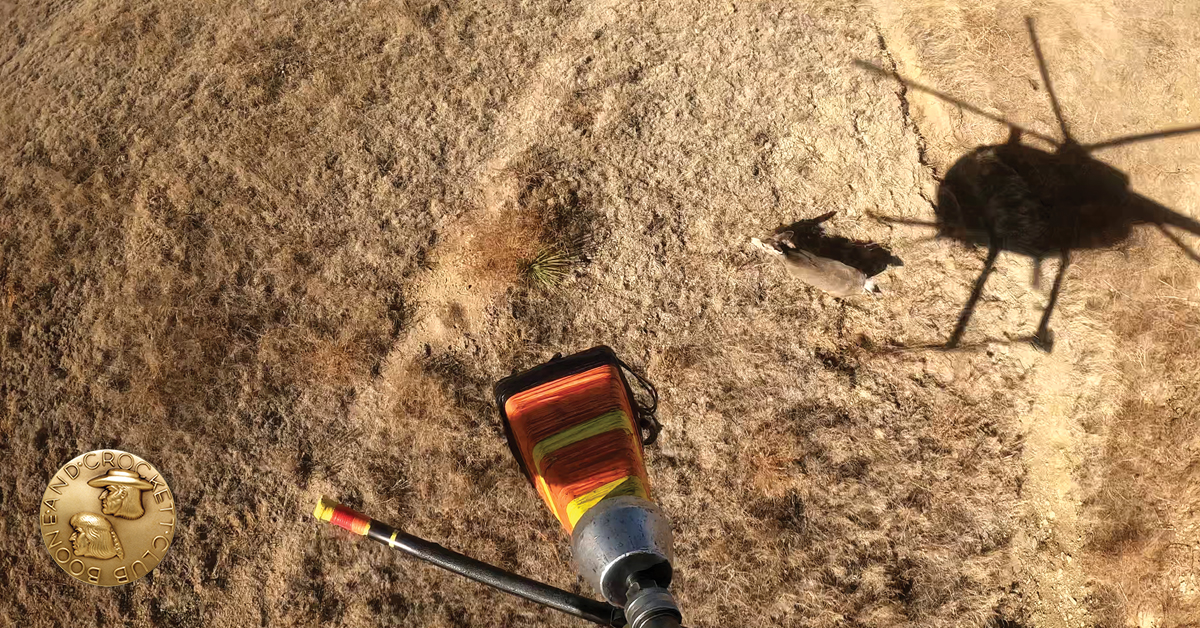
Mule Deer and Pronghorn Research in Northeast Colorado
By Jon McRoberts - B&C Regular Member Boone and Crockett Wildlife Conservation Program at the University of Montana, Patricia Minerich - B&C Professional Member, Chevron U.S.A. Inc., Josh Millspaugh - B&C Professional Membe,r Boone and Crockett Wildlife Conservation Program at the University of Montana, Chuck Anderson, Joe Halseth, and Mat Alldredge - Colorado Parks and Wildlife
As oil and gas development accelerates across northeastern Colorado, wildlife researchers and managers, and private industry collaborate to better understand how these changes affect the region’s mule deer and pronghorn populations. In 2023, Colorado Parks and Wildlife, Chevron, and the University of Montana’s Boone and Crockett Wildlife Conservation Program launched a study to map potential migration corridors, track habitat use, and collect data to guide future conservation efforts amidst a changing landscape.
High Stakes in the High Plains
For centuries, northeastern Colorado’s open plains, wooded draws, and river bottoms have supported healthy herds of mule deer and pronghorn, both of which depend on expansive landscapes to maintain healthy populations. As habitats change with growing human populations, a current understanding of resource needs, factors that impact population growth, and how the species interact with landscape features will keep mule deer and pronghorn a familiar sight on the Colorado plains into the future.
Weld, Logan, and Morgan counties, in northeast Colorado (roughly 30 miles northeast of Denver), serve as important habitat for thousands of mule deer and pronghorn. Historically dominated by large working ranches and intact native prairie, these counties also sit in one of the most productive oil and gas fields in the United States, the Denver-Julesburg (DJ) Basin. The DJ basin spans eastern Colorado, southeastern Wyoming, and parts of Nebraska and Kansas.
In recent decades, Weld County has undergone significant changes. Between 2010 and 2020, the county’s population swelled by nearly 30 percent, making it among the fastest-growing areas in Colorado and reshaping the landscape. Subdivided ranches, also known as ranchettes, have fragmented the open plains into smaller, fenced parcels. Oil, gas, wind, and solar energy development has resulted in access roads, energy infrastructure, and industrial sites across the landscape. Some of these changes were accompanied by awareness and consideration for wildlife conservation, while others were not. Little research has been conducted on mule deer and pronghorn since these changes occurred, and wildlife managers need updated information to inform their management and conservation efforts.
Chevron, one of the largest players in the region, currently holds approximately 600,000 acres in the DJ Basin, mostly within Weld County. In 2023 alone, Weld County produced over 105 million barrels of oil and nearly 800 billion cubic feet of natural gas. Chevron recognized the need to balance energy extraction to support an ever-expanding human population with wildlife conservation and management, and in 2023 began to develop its Comprehensive Wildlife Plan. The goals and objectives of this forward-looking plan include utilizing science-based data to identify focus areas for mitigation and improvement, as well as to inform enhancement measures and planning efforts. To achieve these goals and objectives, Chevron applied an “art of the possible” framework, imagining what was possible. Chevron’s Comprehensive Wildlife Plan features a toolbox of programs including the collaring program of pronghorn and mule deer to ascertain movement, migration, and habitat interaction data; a native seed program that focuses on the identification, collection, and cultivation of seeds native to Colorado; a habitat defragmentation program that plugs existing legacy oil and gas wells reclaiming associated lands; an offset program to establish conservation easements and enhancements to existing easements; and a program of collaboration with external experts like Colorado Parks and Wildlife (CPW) and the University of Montana’s (UM) Boone and Crockett Wildlife Conservation Program. Through the Comprehensive Wildlife Plan, Chevron is employing a science-driven approach to inform the “what, where, and when” elements for applying mitigation and minimization measures to positively impact wildlife and their habitats.
This rapid development is not unique to this part of Colorado. Across the western United States, the combination of energy extraction and suburban growth has fragmented critical migration corridors, potentially increasing mortality risks and reducing habitat quality for ungulates. Sound wildlife research and management must accompany this growth, and our mule deer and pronghorn research project serves as a model for this approach.
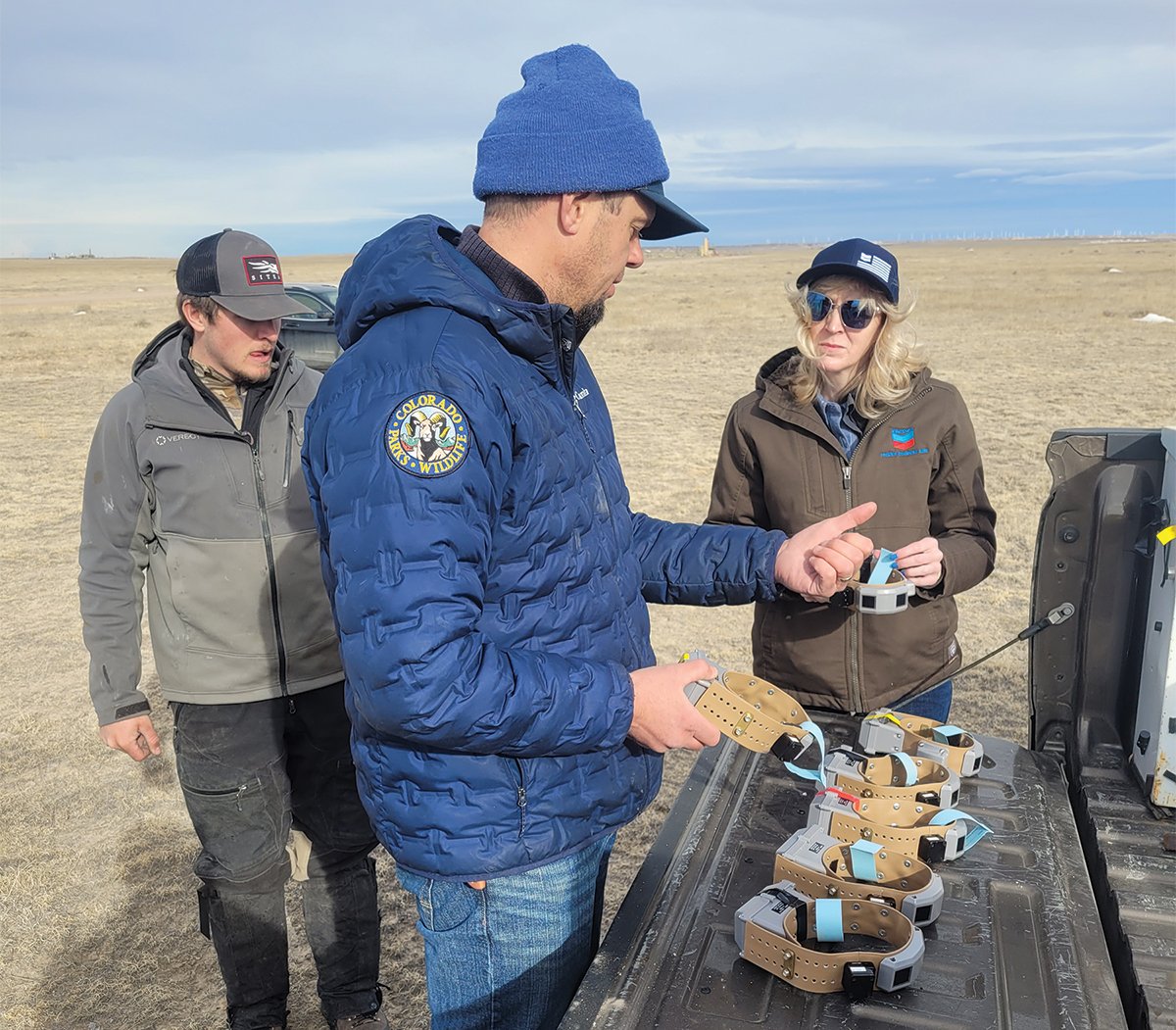
A Collaborative Approach
On a snowy morning in February 2024, Joe Halseth of CPW and Dr. Jon McRoberts of UM were the only customers in the Barnstormer restaurant. Housed in the Greeley-Weld County Airport, this spot was a hangout where current and former pilots could share stories and compare notes. The reason the Barnstormer was empty during what should have been the breakfast rush was because of the weather. Flying conditions were somewhere between poor and dangerous. This morning was scheduled as the start of mule deer and pronghorn capture—the kickoff moment of a project that would promote wildlife conservation in tandem with energy extraction. It was supposed to be the culmination of months of planning among scores of wildlife biologists, wildlife officers, conservation administrators, and numerous private landowners. To achieve the ambitious sample sizes of GPS-collared animals required to draw valid conclusions, it was necessary to go airborne with capture and collaring efforts and contract with a company specializing in net-gunning large mammals from a helicopter. For now, capture efforts were grounded.
The partnership between CPW and UM’s Boone and Crockett Wildlife Conservation Program also included Chevron. Chevron proactively stepped up to fund the research as part of its Comprehensive Wildlife Plan, recognizing that effective oil and gas planning must include wildlife conservation and management based on solid scientific data.
Chevron’s sponsorship of the study also reflects a growing trend of private sector involvement in wildlife research and conservation planning. Across the West, oil and gas companies are increasingly investing in big game monitoring efforts, often in collaboration with universities, state wildlife agencies, and conservation organizations.
In northeastern Colorado, the primary objectives of this study are to delineate key movement corridors and winter range areas, evaluate how habitat features influence selection and avoidance behaviors, and assess the tolerance of mule deer and pronghorn to various landscape disturbances. Over a three to five-year period, researchers will track the movements, habitat use, and survival of 60 collared adult female mule deer and 140 collared adult female pronghorn.
This work builds on decades of ungulate ecology research, but it is uniquely tailored to address the specific land-use challenges of this region. The project’s design also allows researchers to evaluate animal responses to existing features already present in the landscape, offering insight into how pronghorn and mule deer are adapting—or failing to adapt—to the changing environment.
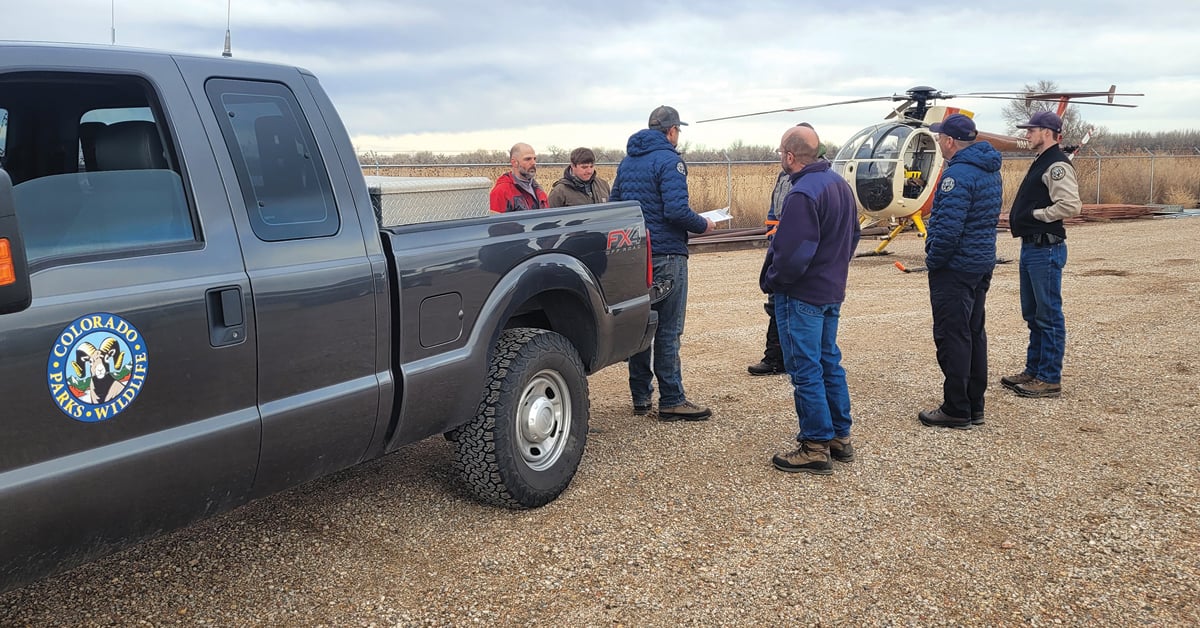
Early Progress and Expectations
Back at the Barnstormer, the weather started to clear, and it wasn’t long before Halseth’s and McRoberts’ cellphones buzzed in unison. The helicopter was airborne, and it was time to go to work. There is an art to net-gunning, and field crews moved efficiently. All methods had been previously approved by CPW and UM Animal Care and Use Committees to ensure the safe and humane handling of animals.
By the close of year-one’s capture season, the sample size targets of 60 mule deer and 140 pronghorn had been captured and GPS-collared. These collars collected 4-5 GPS locations daily and transmitted these coordinates back to CPW and UM researchers via satellite. Collars were also equipped with a mortality sensor that notified project personnel when the collar remained stationary for eight hours, presumably indicating that the target animal had died. With this locational and survival data, as well as supplementary habitat and landscape attribute data, the research team, led by Dr. Joshua Millspaugh, Chair of the Boone and Crockett Wildlife Conservation Program at UM, and CPW researchers will be able to draw conclusions that will benefit mule deer and pronghorn populations, stakeholders who value the species, and the human populations inhabiting the study area.
The study completed its second-year capture event in January and February 2025 to replenish the sample of collared animals that had either died due to documented causes, such as hunter-harvest and vehicle collisions, or experienced a collar failure. While it is too early to draw conclusions, the study team has already seen interesting movements and potential barriers to movement. With new data rolling in daily, the strength that will certainly come from the final results is constantly improving. If research continues as planned, the sample size of locational data for mule deer and pronghorn will exceed a million coordinates, allowing researchers to robustly identify seasonal movements, understand the types of habitats preferred and avoided, and pinpoint specific locations to target for management and potential mitigation projects. By overlaying GPS data with maps of existing infrastructure and development, the team can also begin to assess thresholds, such as whether pronghorn tolerate certain types of roads, fences, or levels of development.
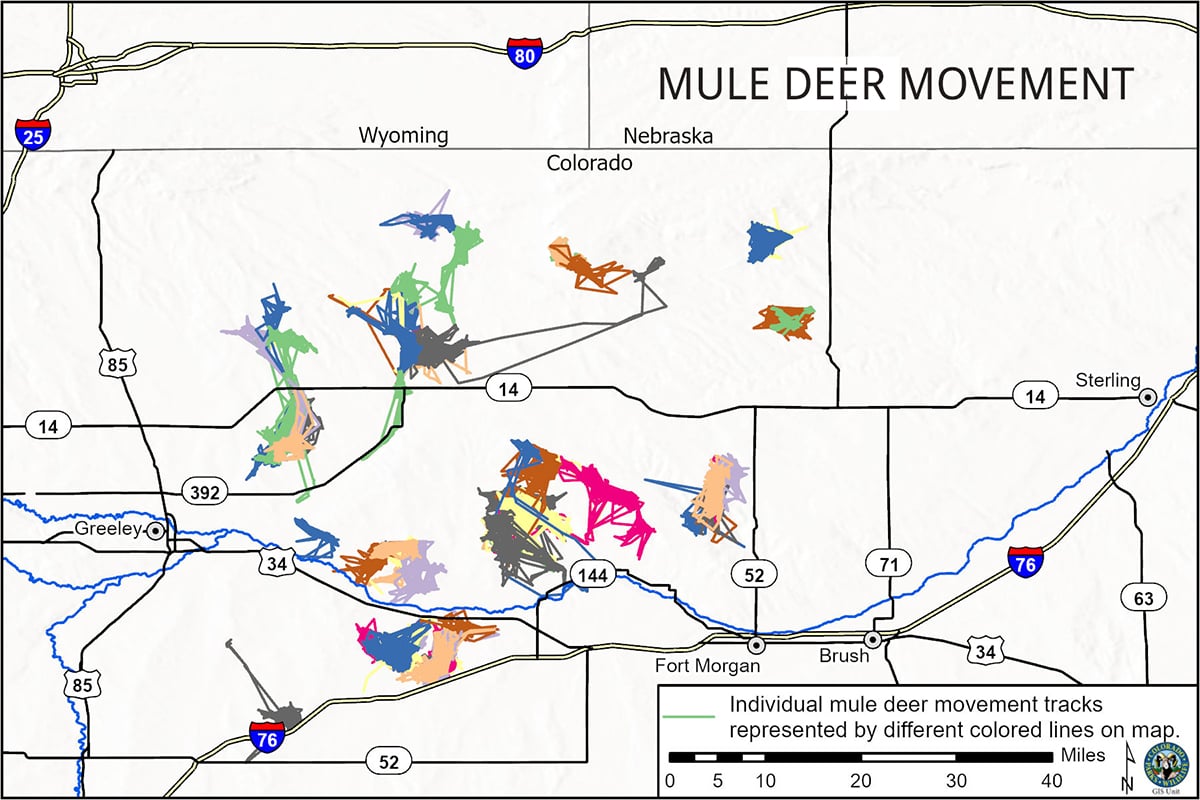
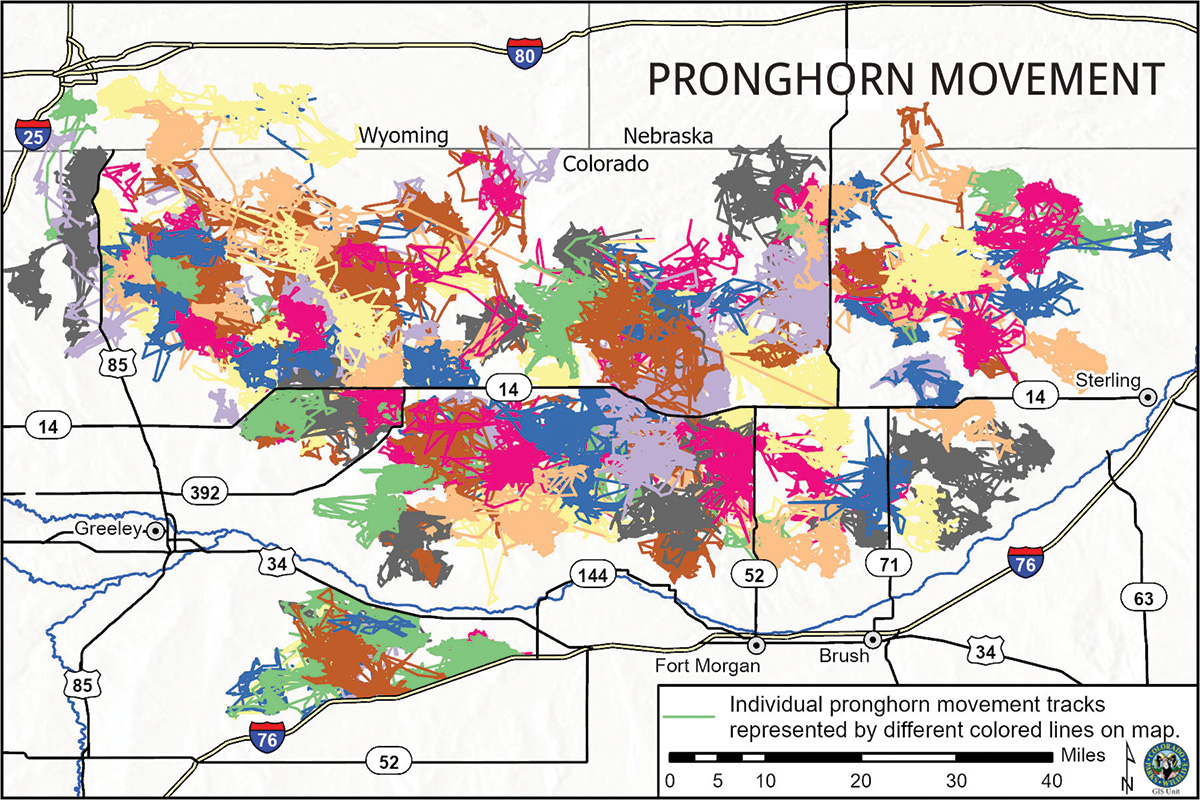
The Big Picture
Ultimately, these data will help managers prioritize habitat protection efforts and allow for informed energy development and wildlife conservation. While this project is focused on a specific region, its benefits extend well beyond northeast Colorado. Healthy populations of mule deer and pronghorn are a foundational element of the state’s outdoor recreation economy. According to recent reports, hunting and wildlife-related recreation contribute over $3.25 billion annually to Colorado’s economy. Beyond economics, thriving big game herds are a marker of landscape health. Pronghorn and mule deer serve as flagship species, meaning that protecting their habitats simultaneously protects a wide range of other wildlife, including grassland birds, raptors, small mammals, and predators. Most importantly, by grounding management decisions in solid science, projects like this ensure that conservation efforts are proactive rather than reactive. Future generations of Coloradoans will inherit landscapes where wildlife conservation and energy development are not mutually exclusive, but can co-exist, if the right steps are taken today.
